Like all exhibitions organized at Bozar, the Spanish Still Life did not leave the viewer wanting. The set-up was beautiful, the light was fairly dim and the paintings simply mesmerizing. The exhibition was curated in a chronological order and the evolution of the style was captured and clearly explained to the public. I have always enjoyed still life painting, my first memory of seeing such works of art takes me back to my maternal grandparents’ living-room library and to a small booklet with colored images they quite unknowingly pushed under my nose. It became one of my favorite toys.
The Bozar Spanish Still Life exhibition was the perfect trigger to start investigating the role of foodstuffs in the still life paintings and, more broadly, cast a look at the evolution of this style.
Depicting the world around us has been one of the first human artistic expressions; cave walls covered in images of bison, horses, deer or other large animals stand as testament. Obviously, the animals portrayed were very much alive and often shown in motion, the cue I’d like to take from these ancestral drawings is our inclination to immortalize what we considered as food at a given time. Still life is described as “one of the principal genres (subject types) of Western art – essentially, the subject matter of a still life painting or sculpture is anything that does not move or is dead” (Tate Britain). The subject matter can be anything man-made, such as books, maps or goblets or natural objects. This is where food elements come into picture, quite literally. We are looking at an astonishing display of fruits, vegetables, game or other animals, cakes and confectioneries, and so many other edible delights. Surely, there is a symbolistic associated with these images, like the skulls and pearls vanitas, which illustrate the certainty of death and the threats of a misguided life, filled with unnecessary follies and luxuries. The food still lifes are, for me at least, a celebration of
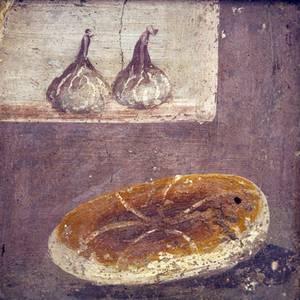
life, with all its pleasures and enjoyable moments. In way, I believe this is linked to the origin of the style, which can be traced back to still lifes Hellenistic wall decorations found in Italy. The “second style” was invented in Greece and brought to Italy by Greek artists. The fresco-paintings of the interior of the houses were meant to create the illusion of space, later on progressing towards more decorative elements. A celebration of life’s pleasures, indeed!
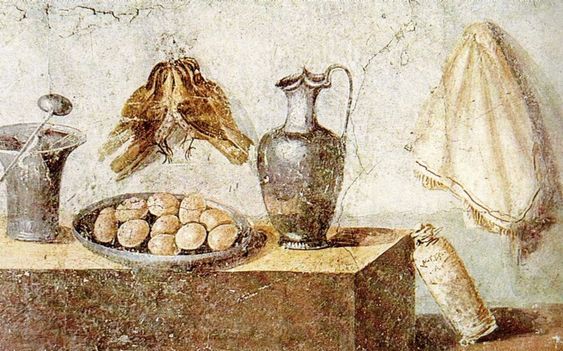
The early still life Spanish painters were heavily influenced by naturalism as an aesthetic choice; the first recognized painter is Juan Sanchez Cotan, whose works are striking through their simplicity with an almost photographic quality of details. We find all familiar elements in Cotan’s works of art: apples, melons, quinces, cucumbers, cabbages, cauliflowers…all perfectly arranged on windows sills or hanged from above. If feels as if we are peering into another world, where everything is dominated by a cosmic,
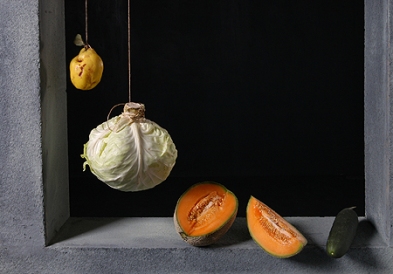
mathematical order. Suspending fruits and vegetables was a common practice in the 17th century, aimed at keeping the produce from rotting, yet in Cotan’s paintings we feel like we get more than a simple depiction of everyday life. There is no embellishment, no decorative elements, no eye-grabbing central focus point, the dark background adding a spatial, void-like dimension. We are looking at a simple, balanced and serene scene with a mystical, abscons quality.
The term “bodegones” was used as of the the 17th century to cover all still life works of art showing animals, fruits, vegetables or other food items. Stuff that would normally be found in a bodega kitchen. The interesting part is that most of the bounty shown in the painting is take out of the space of the bodega and simply placed on a table or cupboard. The link with the actual bodega is only referred by means of association: this is a painting of food, hence the scene takes place in an eating establishment, a bodega.
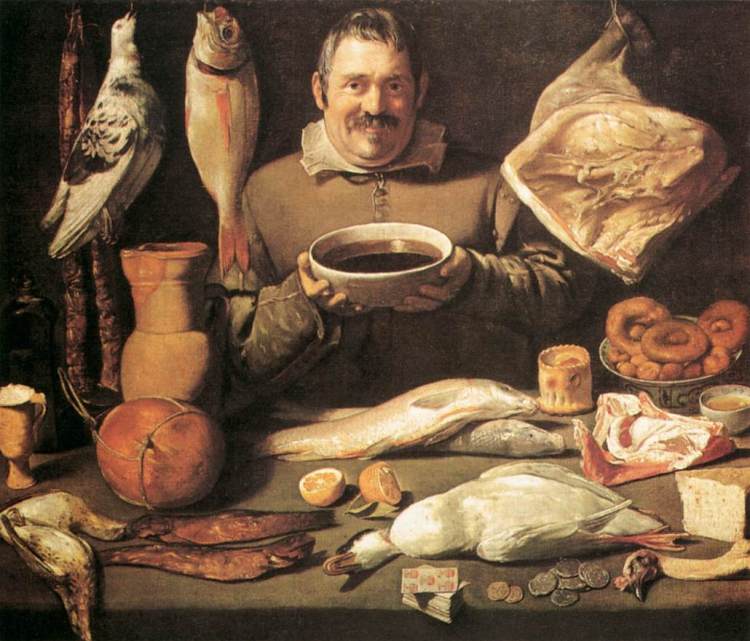
The style continued to evolve and change and as time moved on, the simple paintings of Cotan and other bodegones painters made place for more sophisticated, ornate Baroque styles. Rich colors and busy settings were now de rigueur, the overcrowded Spanish kitchens were portrayed in minute details. Following the natural cycle of life, many bodegones painters captured the seasonal bounty in their art. I like to regard this as a reminder that no matter the season, nature always gives us something of wonder and pleasure.
While there were no significant changes in the beginning of the 18th century, the formalized approach to arts began to crystallize in the second half of the century, with the establishment of the first fine arts academy, the Real Academia de Bellas Artes de San Fernando. The still life style was still considered inferior, ranking last after history painting, portraiture, genre painting (scenes of everyday life) and landscape. Still life and landscape were considered lowly because they did not involve human subject matter
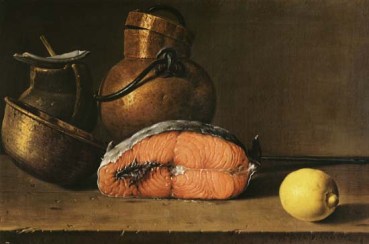
(Tate Britain). However, the appetite for the natural wonders of the world was growing and the painters of fruits, vegetables and animals started to be viewed in a different light, through a scientific lens. They were documenting the world around us, with Luis Egidio Melendez as main representative. I would like to share a story told by the lovely guide at Bozar. Apparently, Melendez’s father, Francisco Meléndez de Rivera Diaz was himself an acclaimed painter and was appointed King’s Painter of Miniatures in 1725. He later chaired the painting section of the newly opened Real Academia, as honorary director. Due to a quarrel in which Melendez’s father attacked the director of the Academy, claiming founding rights of the institution, the young painter found himself cast away, all his newly achieved glory
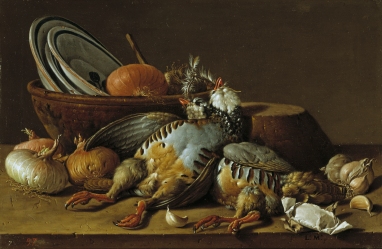
shattered. He traveled throughout Europe, spent time in Italy, returning to Madrid in 1753. His efforts to regain the favors of the king were in vain and he ended up embracing the still life decorative style, fit for painters without royal patronage or support from the Academy. He sold his paintings in the open market, one can only imagine Melendez’s fruit and vegetables still lifes among the real bounty sold on market stands. This is why his later paintings are small in size: they were bought by rich and no-so-rich merchants and were easily transportable. Despite his talent and amazing creations, Melendez died penniless and anonymous.

Furthermore, the most fascinating figure of Spanish art, Goya, has also explored the genre. When we talk about Goya, we don’t muse over his still lifes. Truth be told, Goya’s genius has given us more enticing works of art, that arrest the viewer and capture their
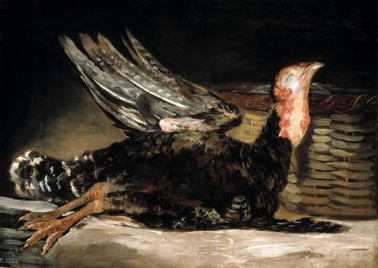
deepest emotions and fears. But Goya did create a few still life paintings, which were only shared in private circles and kept in the family till mid-19th century. During the the war with Napoleon, between 1808-1812, he painted twelve still lifes without commission. This makes me speculate that they were not made to attract the public or to raise his
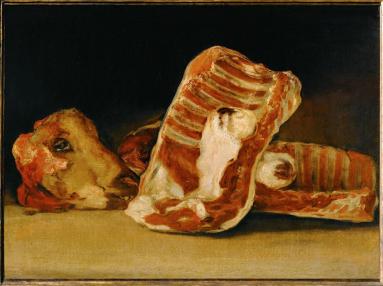
fame, but created as simple experiments by the complex artist that Goya was. One might even hazard to imagine that Goya did these paintings as an outlet for his own angst, a mirrored reaction to the calamities of the war. The subjects of Goya’s still lifes are not colored, juicy fruit and vegetables, but dead livestock. Dead fish, a broken-neck turkey, bloody carcasses. There is no happiness or joy, simply death. Artistically, he breaks from the main style of still lifes, one could almost feel a return to the old masters, like Cotan. A dark, somber background with the subject of the painting flooded with light, this is Goya’s take on still life genre.

The modern painters picked up the still life themes, from the French Impressionists to the Cubist and Surrealist painters. For the latter, the still life genre offered a means of
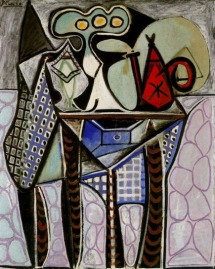
artistic expression that went against the mimetic, naturalistic origin of the genre. They deconstructed everything, used bold, unseeming colors and brought a new air of avant-garde to the still life style. Picasso’s Cubist still lifes focus on man-made objects, with few natural elements. Yet, one can clearly see that Picasso still remains faithful to the precepts of the genre: unrecognizable foods do appear in his work. The Still Life on a table (1947) picks up an almost bodegonas theme, the circle seems to be complete. Miro does the Still Life with old shoe in 1937; the acidic, saturated colors evoke a technicolor nightmare. A piece of bread
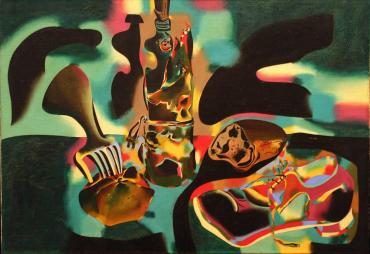
and a tomato, Spanish food staples, sit comfortably on the table next to the old, worn-out shoe…a reminder of decay and death. Other modernist painters gave their own interpretation to the genre of still life; I particularly like the dark paintings of Jose Guttieres Solana or Isidre Nonell.
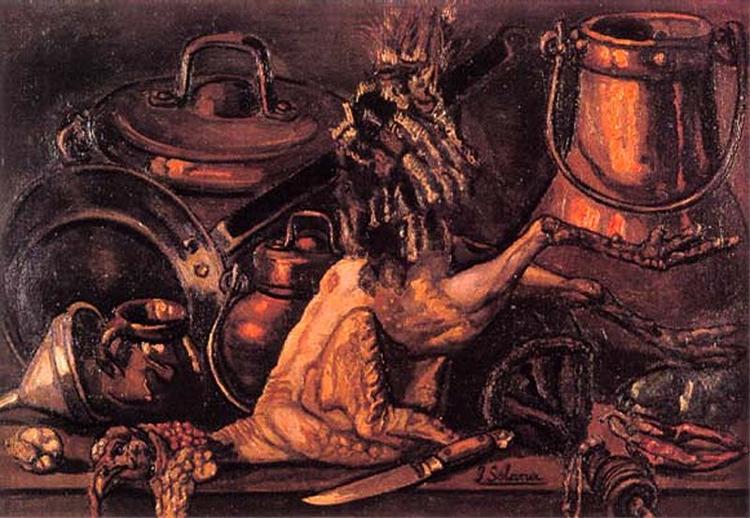
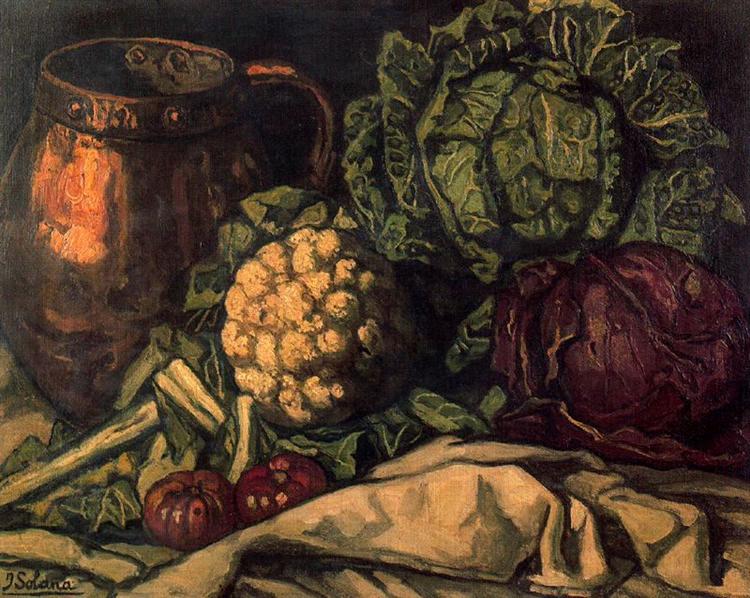
While the first half of the 20th century was marked by abstraction in all its shapes, there were painters that went back to the old approach of still life, bringing a new, modernist influence. Equipo Cronica, the artists consortium, goes back to the mastery of Cotan in a
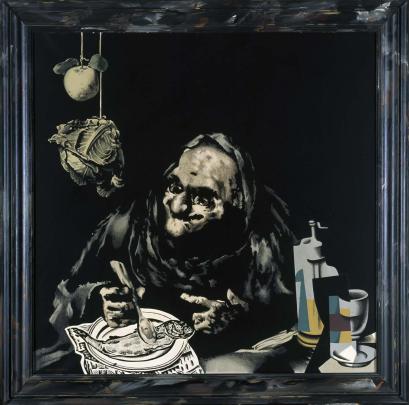
literal way. They insert a Goya inspired character having a cubist meal in the opening of Cotan’s window sills with hanging produce. In 1988 Miquel Barcelo paints the Big Spanish Dinner, a mix of Spanish delights, still boiling on the stove top. We see paella, mussels and other dishes being prepared in pans. Barcelo uses different techniques to give the impression of texture. In his works, he tries “to connect the past with the present” and believes that “the still life genre is not a static genre but it is still evolving, having new artistic possibilities with expressions such as video art or photography”.
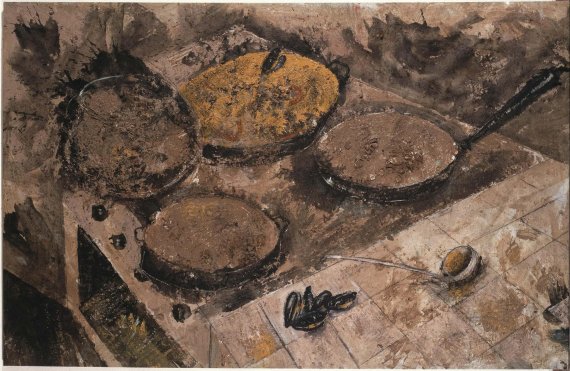
As I reflect back at the wonderful art at the Bozar exhibition, I am wondering why did the early bodegons painters decide to incorporate an abundance of food stuff in their work. The answer could be laying in the visual qualities of such produce: various colors, shapes and textures, all waiting to be captured by the naturalistic eye of the artists. And a reminder for all of us that natural produce is truly beautiful.

Pingback: Reading List (3/7)